Pakistani Muslims display a strong devotion to Islam, but that does not translate into support for Islamic political parties. Pakistan’s political landscape is largely influenced by weak political institutions and a strident relationship between its civilian government and the military. The Pakistani government is not seen as holding sway over the country’s military. This is usually attributed to weak political institutions and parties, incompetent political leadership and the entrenched power of the civil-military bureaucracy. These factors are significant, but there are other contingent factors arising from the country’s demography and geography which play a significant role in shaping Pakistani state and society.
The social and cultural rhythms of Pakistani society have been profoundly influenced by Islam
To appreciate the role of Islam in Pakistan requires a sound knowledge of the history of Islam in South Asia and, in particular, of how Islam came to have roots in the South Asian sub-continent. The historical evidence shows that it was not the coercion of Muslim invaders but the Sufi khanqahs (place of Sufi worship) that played a pivotal role in spreading Islam. They wove themselves into the complex cultural patterns of the sub-continent and helped to remove the mistrust and isolation of various groups. They were also important in the development of a distinctive South Asian Islamic tradition; namely, Sufi Islam.
The khanqah shrines gradually evolved into Sufi cult associations with millions of followers, led by the hereditary descendants of the Sufi saints. Because of their spiritual and social influence they were eventually co-opted by the state and received large jagirs (feudal land grants), which extended their influence to the economic and political spheres. Over a period of time, this evolved into a pir-zamindar (shrine elites–feudal landlords) alliance. The union became the core of the Muslim society’s social stratum, as well as part of the development of the state in the sub-continent. After 1947, it emerged as one of the dominant forces in Pakistani state and society.
The rise of Sufi Islam brought it into conflict with the other dominant Islamic tradition: the scripturalistic tradition, led by ulema-Islamic scholars. The ulema had been at the centre of various Islamic reform movements historically in the Indian subcontinent, and now this was the case in Pakistan. The best examples of recent ulema-led reform movements are the Deobandi movement and Jamaat-i-Islami. The central concern of these movements is to expunge Islamic culture of extravagant customs such as lavish weddings, dowries and other ritual celebrations, which they regard as un-Islamic. These movements are also anti-pir and anti-saint cults, and downplay these institutions in favour of individual responsibility to scriptural norms. They ask their followers to be guided only by the Sharia.
The ulema see themselves as following the teachings of great past reformers, including the Prophet Muhammad himself, for whom the ending of false customs and the creation of religiously responsible individuals was central. The ulema and their movements, in short, have been engaged in a renewal of the teachings of the Quran and the Prophet. They are the ideologues of scriptualistic Islam from which contemporary Islamic fundamentalist movements derive ideological inspiration.
In Pakistan, the ulema are also committed to breaking the nexus between the state and the elite of popular Sufi Islam, replacing it with scripturalistic Islam. Their attempts to achieve this goal have been largely unsuccessful until recently. However, increasing urbanisation, literacy and modernisation are increasing their influence among urban populations. The Islamisation program of the regime of General Zia ul Haq—with its blue-print drawn from orthodox and puritanical movements, including the Deobandis and Jamaat-e-Islami—has boosted the role of scripturalistic Islam.
One of the most significant developments arising from these Islamisation policies was the privileging of orthodox and puritanical sects. These sects had a close theological affinity to Wahhabism and the political parties Jamaat-i-Islami and Jamiat-i ulema-i-Islam, which received funding and government patronage at the expense of Bralevis, of which most Indians are part). Governmental support strengthened orthodox Sunni institutions by providing funds to their existing religious seminaries (madrassas) and by establishing new ones. The Zia ul Haq government saw the expansion of these orthodox seminaries as an instrument for entrenching orthodox Sunni identity. They continue to play a significant role in fanning sectarian conflicts in Pakistan and have become a major source of the militarisation of Pakistani society.
These developments have eroded the political domination of popular Islam in the Pakistani state as an institution, as well as in society at large, although popular Islam still remains a pervasive religious tradition among the masses.
There have been periods when the pendulum of political power has swung in favour of scripturalistic Islam only to galvanize opposition to it among the masses. However, religious, political and geostrategic developments have strengthened scripturalistic Islam’s position in Pakistani society and in the state.
As a result, Pakistan is entering a new phase that is likely to see increasing conflict between the two Islamic traditions for political hegemony. It is manifesting in the increasingly violent sectarian conflicts as well as in the ethnic-based insurgencies that continue to pose a serious threat to the social and political stability of the country.
Religion and Politics
Evidence shows that Pakistani Muslims display strong attachment to their faith. A comparative, multi-country study of attachment to key religious tenets and beliefs found Pakistanis to be more devoted and compliant compared to respondents from several other Muslim countries (Table 1).
Table 1: Level of Orthodoxy of Religious Beliefs

Source: Hassan. Islam and Society (2013); Indian data are from unpublished Survey of Indian Muslim Religiosity 2016 by the author.
Does this affinity and attachment affect their politics and political choices? Voting data shows a clear preference for a pluralistic political culture, signifying support for democratic ideals (Table 2).
Table 2: Voting Trends in Previous Elections in Pakistan
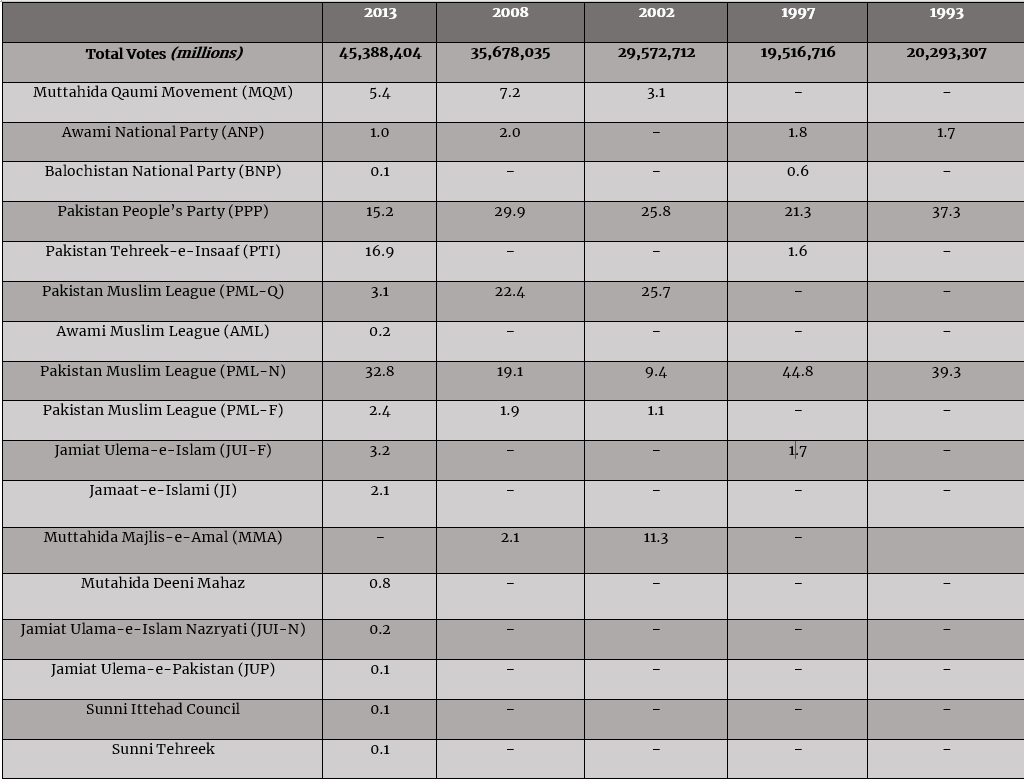
Source: Election Commission of Pakistan
This has significant implications for radical Islamist movements. Paradoxically, the lack of support for such movements tends to radicalise them further, transforming them into increasingly secretive and violent organisations. Their ruthlessness reflects a desire and a deliberate strategy to gain public attention and is symptomatic of their desperation, not popularity. It is fueled by an awareness of their lack of support and powerlessness, as well as a desire for revenge and religious fanaticism.
The Pakistani State
In the roll call of Pakistan’s infirmities, various weaknesses of the Pakistani state, particularly the strident relationship between its civilian government and the military, is frequently near the top. Unlike most democratic settings, Pakistan’s elected civilian government is not seen to hold sway over the country’s military. Scholarly debates and analyses have attributed this to weak political institutions and parties, incompetent political leadership, the entrenched power of the civil-military bureaucracy and threats to Pakistan’s sovereignty and territorial integrity. They, in turn, have failed to develop the basis for a robust and effective political and constitutional system, seriously impeding the government’s ability to respond to the myriad of internal and external challenges it faces related to national cohesion and integration, ethnic tensions, sectarianism, regional inequalities and international relations. In this space, the bureaucratic military elite has become steadily more assertive, increasing its power at the expense of the political elite.
Between 1980 and 2000, four democratically elected governments were dismissed by the country’s presidents on charges of corruption, inefficiency and their inability to meet security challenges, resulting in the strengthening of the civil-military bureaucracy. Indeed, during Pakistan’s 70-year history, it has been governed by civilian bureaucrats or military generals for almost 45 of those years. These factors have undoubtedly played a significant role in shaping civil-military relations in Pakistan.
Yet, I suggest that there are other contingent factors arising from the country’s demography and geography that have contributed significantly to this situation. In most discussions these factors do not get the attention they deserve. I argue they have played a significant role in shaping civil-military relations, governance and the security challenges that the Pakistani state has faced from the very onset.
The Montevideo Convention on Rights and Duties of the States defines a state as possessing a permanent population, a defined territory and a government capable of maintaining effective control over its corresponding territory and conducting international relations with other states. Figures 1 and 2 show the geographical contours of the state of Pakistan and the ethnic heterogeneity of its population. The most striking aspect of Pakistan’s demography is that it is made up of six ‘nations’, each of which is divided between two or three countries. They are all predominantly Islamic but also endowed with their own distinct, historically grounded cultural identities. The geographical contour of Pakistan and its demographic heterogeneity has had profound implications for Pakistani’s territorial integrity, social cohesion, political stability, security and international relations.
Figure 1: Pakistan’s Population: Ethnic Groups and their Geographical Distribution
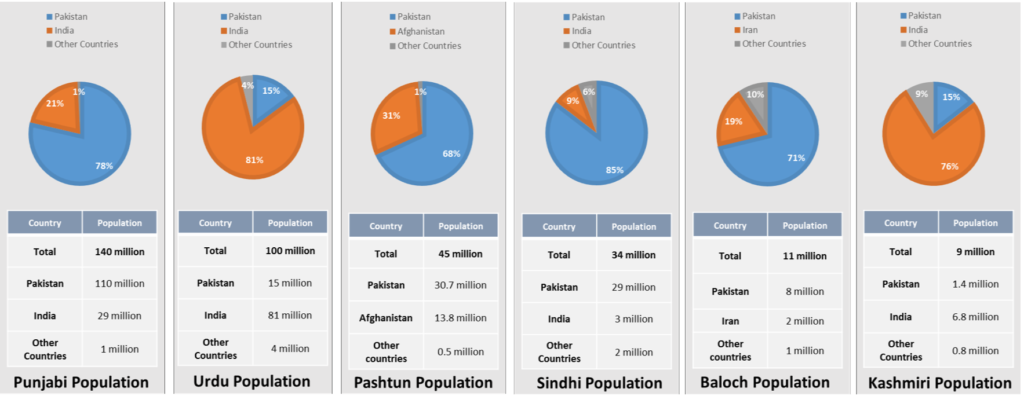
Source: Compiled from Pakistan Census data 2017 and various other sources of Pakistan demography by the author
Figure 2: Map of Pakistan & Major Ethnic Groups
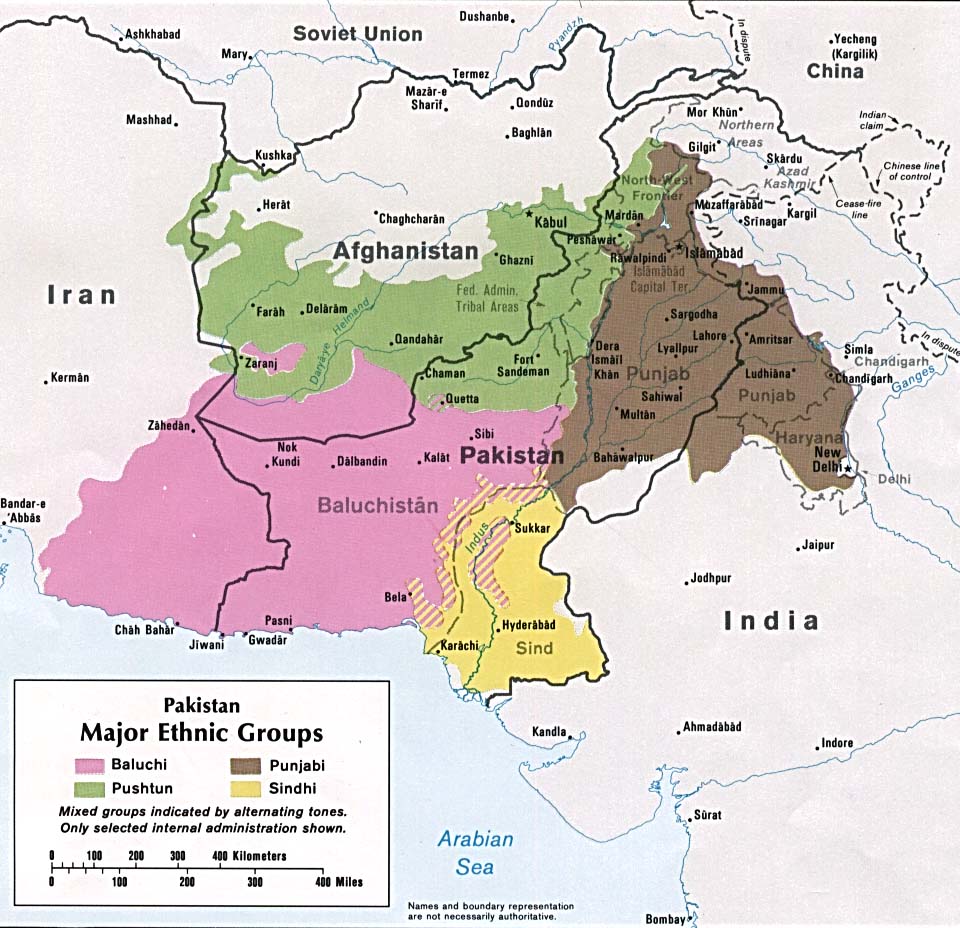
Source: University of Texas Libraries, The University of Texas at Austin
Kashmir has been a source of intermittent military skirmishes and conflicts with India since 1947—seriously impacting Pakistan’s relations with its neighbouring state. The area remains a major political and security challenge for Pakistan. Baluchistan, Pakistan’s largest province, straddles Pakistan and Iran. It is resource-rich and sparsely populated. Around 80 percent of the Balochi population resides in Pakistan, while the rest live in Iran and Afghanistan. It too has been a site of decades of ethnic conflict with the Pakistani government over regional inequalities and the exploitation of its mineral and gas resources, which have failed to deliver real economic and social benefits to Balochis. The Pakistani army has carried out numerous operations in the province under the rubric of counter terrorism, only serving to heighten ethnic tensions. The province also continues to be a site of incidents carried by Balochi nationalists.
The most serious political challenge facing Pakistan, however, concerns the conflict in Afghanistan, which, like the other disputes, also has a significant demographic dimension. The Pashtun nation consists of approximately 45 million people. Pakistan is home to 31 million Pashtuns or 70 percent of the Pashtun nation, with Afghanistan home to the other 14 million or 30 percent. The Pashtuns are overwhelmingly a tribal society, with their identity grounded in the historical memory of a common lineage, Islam and the over-arching universal tribal ‘legal’ code of Pashtunwali. These features constitute the social and cultural ‘glue’ of solidarity among the Pashtuns of both countries.
While the Pashtunwali rules are not a detailed legal code, they provide an all-encompassing framework for behaviour and for managing conflicts in the Pashtun society. According to the code, when one’s honour is harmed a person has a duty to respond by seeking revenge greater than the original slight. This dynamic helps us to gain a deeper insight into the Taliban insurgency. Most Pashtuns are deeply conservative and strongly attached to their tribal values. Moreover, the majority of Taliban fighters are Pashtuns in culture and character, with a deep sense of shared identity. They are outraged by those who usurp their autonomy and denigrate their culture. The core logic of the Taliban insurgency is that they are fighting for the defense of their country, their honour and their religion, and to avenge the deaths of their relatives killed by Western forces and their allies alike.
The proxy wars between the United States and the Soviet Union in Afghanistan, following its occupation in 1979 by the Soviet Union, and after 2001 between the United States, its allies and the Taliban, have made Pakistan an intersection of several global fault-lines. This too has had serious consequences for its economy, political stability, sovereignty and territorial integrity. Under these conditions, and in the face of the external threat of aggression and war, the Pakistani military has been obliged to perform its constitutional duty to ensure national security and national unity, and to assist the government in its humanitarian mission. The conditions in Afghanistan, over which Pakistan has no real control, has compounded the problems of chronic political instability and difficult civil-military relations.
In short, governmental failings in Pakistan are deeply affected by its weak political institutions and parties and incompetent political leadership, and also by the country’s geography and demography. This reality is reflected in public opinion polls that show a low level of trust in the government, parliament, political parties and politicians. In this context the most trusted institution in the country is Pakistan’s army, which is trusted by 82 percent of the population. But despite the lack of confidence in political institutions and high trust in the army, most Pakistanis do trust democracy. According to a recent Gallup Poll, 73 per cent of Pakistanis preferred democracy, while only 21 per cent would rather have a military dictatorship.
Is Pakistan a Failing State?
Pakistan is often seen as divided, disorganised, economically backward, corrupt, violent, unjust, oppressive towards women, and home to an extremely dangerous form of extremism and terrorism. Does this indicate that it is a failing state? We can answer this question by examining the Pakistani state’s ability and capacity to deliver ‘public goods’ for improving the socioeconomic well-being of its citizens and to eradicate the scourge of terrorism that has plagued Pakistan in recent years.
The evidence shows that there have been general improvements across several major development indicators, indicating Pakistani state’s capacity and ability to deliver public services to enhance the general well-being of its citizens. According to 2019 UNDP Report on Human Development in Pakistan, between 1990 and 2018, Pakistan’s HDI (Human Development Index) value increased from 0.404 to 0.560, and increase of almost 39 percent, life expectancy at birth increased by seven years and years of schooling increased by 2.9 years and expected years of schooling increased by 3.8 years.
Figure 3 and Table 4 provide an overview of terrorist incidents in Pakistan over the past two decades. It shows that there was a significant increase in terrorist incidents between 2006 and 2016. However, over the past few years, there has been a dramatic drop in the number of terrorist acts, suggesting the ability of the security forces and other law enforcing agencies of Pakistani state to manage and defeat terrorism. Yet, that has come at a significant cost. Statistics calculated from South Asia Terrorism Portal show that terrorism accounted for 62,403 fatalities between 2002 and 2018 in Pakistan. Of these, over half of the deaths were of the terrorists themselves. Of the remaining number, 21,890 were civilian deaths and 6,802 were security force personnel. Pakistan is frequently accused of being soft on terrorists and terrorism; however, the evidence in Table 3 does not indicate that to be the case. There is no doubt that more needs to be done to eradicate terrorism. However, the evidence shows that the state security organs have the ability and the capacity to achieve this.
Figure 3: Terrorist Incidents in Pakistan
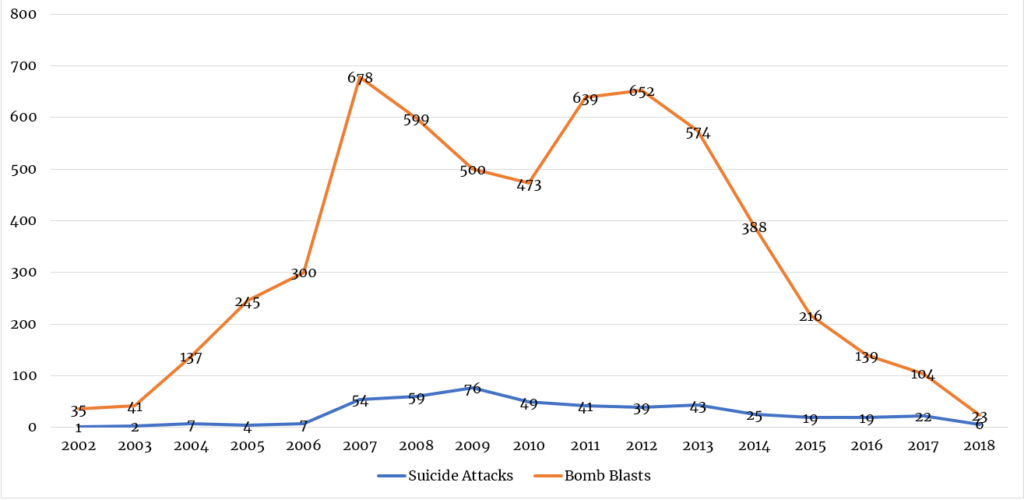
Source: South Asia Terrorism Portal
Table 3: Fatalities in Terrorist Violence in Pakistan

Source: South Asia Terrorism Portal (until 25 March 2018)
Finally, it may be instructive to consider the views of the Pakistani public about the major problems facing their country, as indicated in Figure 4. Economic problems, including unemployment, inflation and poverty, are seen as the largest issues facing the country by more than half of the Pakistani public. The problem of corruption is perceived to be the main problem by 14 percent, followed by domestic terrorism and the energy crisis, by seven and eight percent respectively. In short, economic problems, unemployment and inflation are perceived to be Pakistan’s biggest problems, followed by corruption.
Figure 4: Public Perception of Pakistan’s Biggest Problems
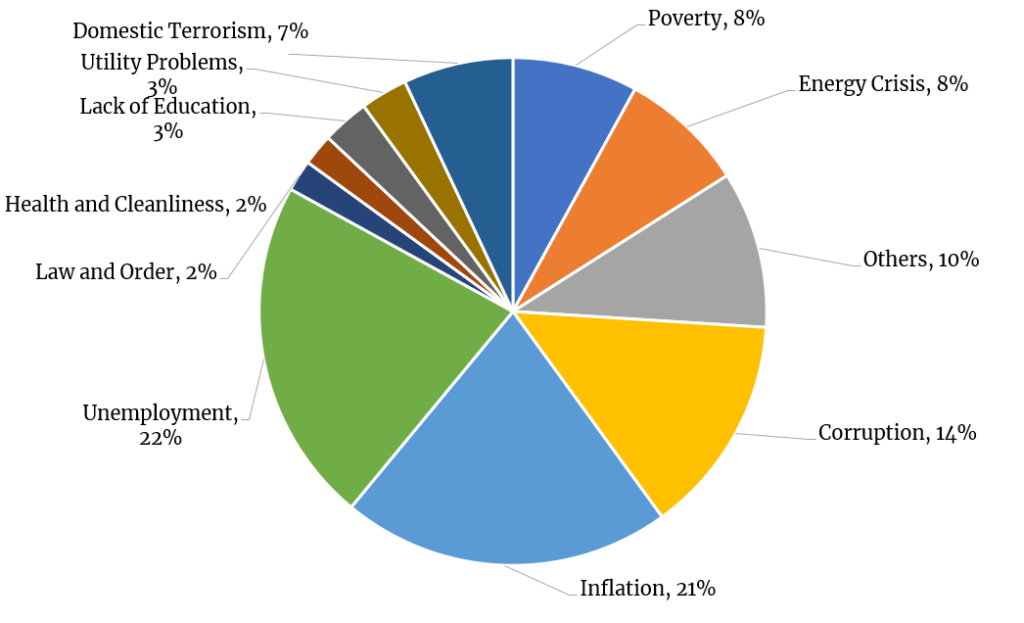
Source: Survey Conducted by Gallup Pakistan, 10 October-1 November 2017.
Religion has played a pivotal role in shaping the social and cultural patterns of Pakistani society
Religion is a source of social cohesion, as well as sectarian tensions in society. It also shows that strong attachment to Islam does not translate into electoral support for religious parties. The tensions that emerged between the followers of the Sufi and scripturalistic Islamic traditions, following the introduction of the Islamisation program by General Zia ul Haq’s regime, have escalated into conflict, which is fanning sectarian violence and posing a serious threat to the country’s political and social stability. Poor governance is the result of weak political institutions, as well as the country’s geography and demography.
Conflict with neighboring countries and the war in Afghanistan has made Pakistan a melting pot of several global fault-lines, which has had serious consequences for the country’s economy, political stability, sovereignty and territorial integrity. These conditions have compounded problems of chronic political instability and difficult civil-military relations. Notwithstanding these challenges, the Pakistani state has succeeded, albeit moderately, in improving country’s socioeconomic and health conditions. The security and law enforcement agencies of the state have made a significant contribution to reducing terrorist incidents in the country and have enhanced public safety and security by mitigating and countering the challenge posed by terrorism. In many ways the Pakistani state and society are surprisingly tough and resilient.
Banner image: College and university students from Islamabad and Rawalpindi, 2015. Credit: US Embassy Pakistan/Flickr




